2024年高考二轮复习英语专题突破题型二: 阅读七选五 第一节 最新考情面面观 课件 (共26张PPT)
文档属性
| 名称 | 2024年高考二轮复习英语专题突破题型二: 阅读七选五 第一节 最新考情面面观 课件 (共26张PPT) |  | |
| 格式 | pptx | ||
| 文件大小 | 2.0MB | ||
| 资源类型 | 教案 | ||
| 版本资源 | 通用版 | ||
| 科目 | 英语 | ||
| 更新时间 | 2024-04-17 22:26:54 | ||
图片预览


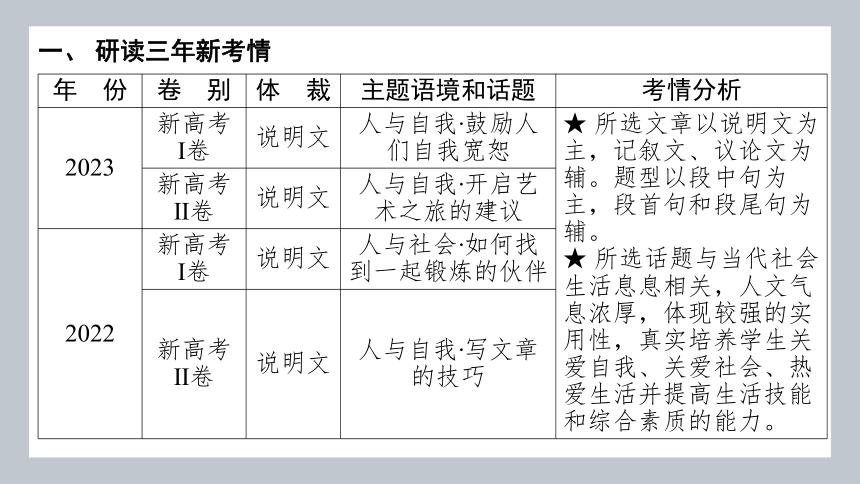

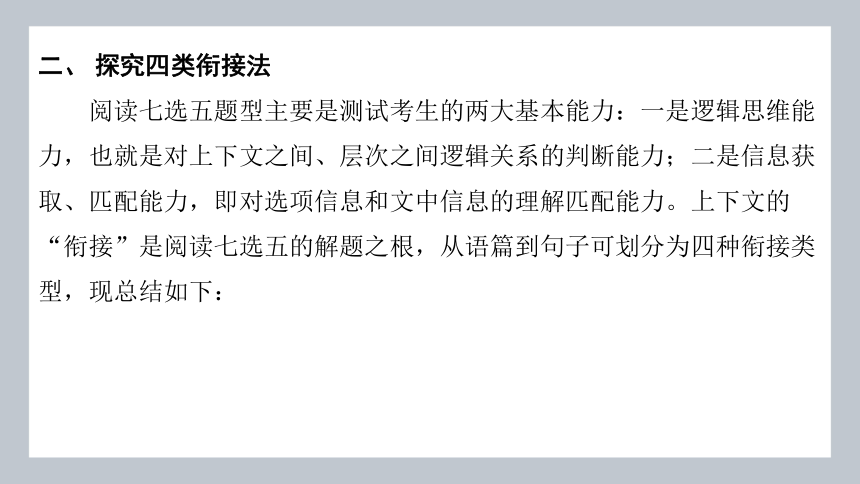
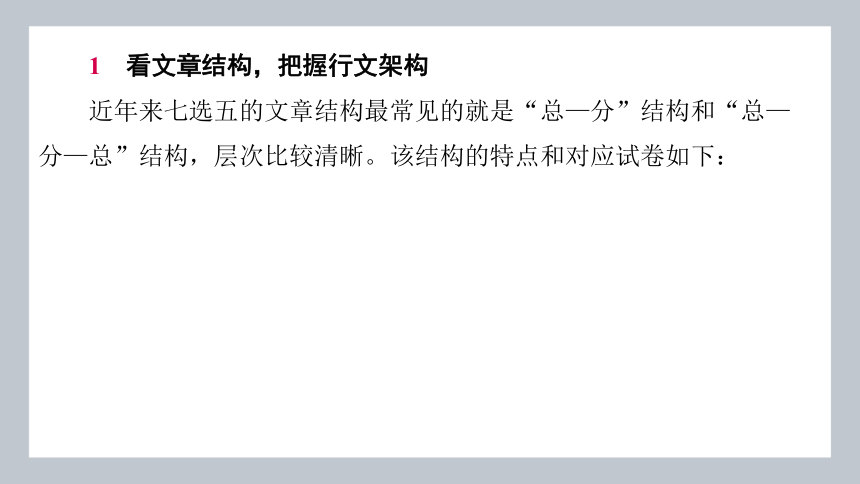
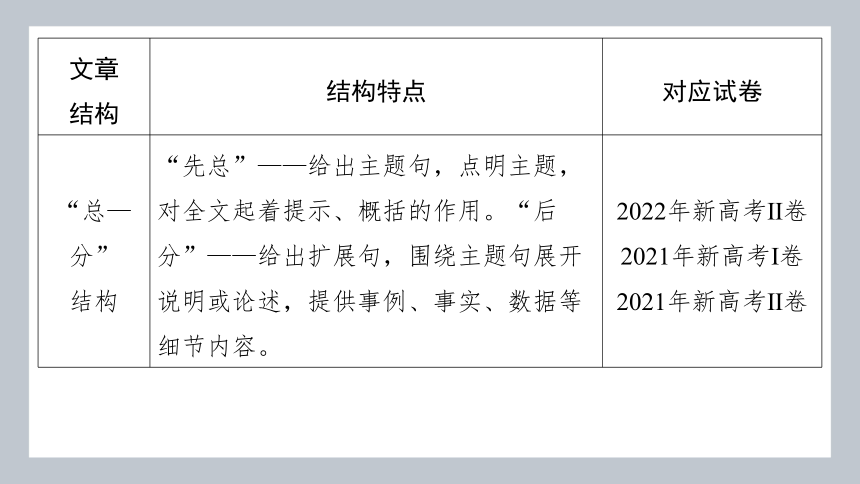
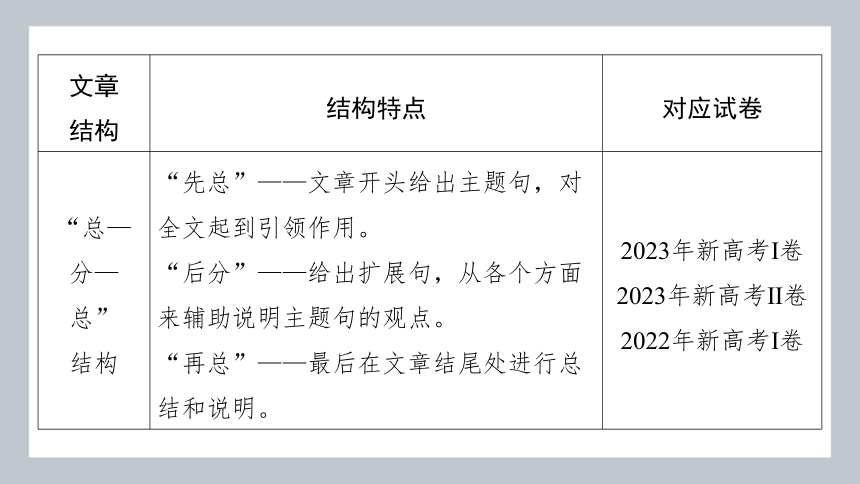
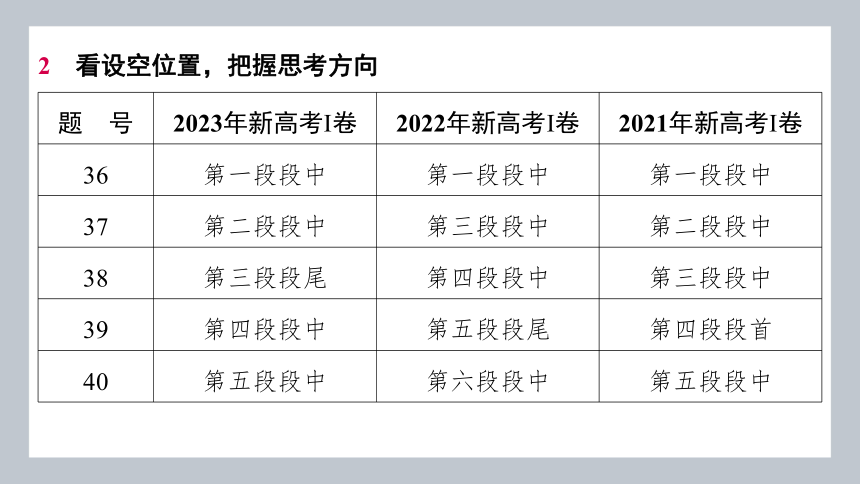
文档简介
(共26张PPT)
题型二 阅读七选五
第一节 最新考情面面观
一、 研读三年新考情
年 份 卷 别 体 裁 主题语境和话题 考情分析
2023 新高考 Ⅰ卷 说明文 人与自我·鼓励人
们自我宽恕 ★ 所选文章以说明文为
主,记叙文、议论文为
辅。题型以段中句为主,段首句和段尾句为辅。
★ 所选话题与当代社会
生活息息相关,人文气
息浓厚,体现较强的实
用性,真实培养学生关
爱自我、关爱社会、热
爱生活并提高生活技能
和综合素质的能力。
新高考 Ⅱ卷 说明文 人与自我·开启艺
术之旅的建议
2022 新高考 Ⅰ卷 说明文 人与社会·如何找
到一起锻炼的伙伴
新高考 Ⅱ卷 说明文 人与自我·写文章
的技巧
年 份 卷 别 体 裁 主题语境和话题 考情分析
2021 新高考 Ⅰ卷 记叙文 人与社会·待在巴
黎的体验 ★ 新高考近3年基本都是
考全句式,也不排除今
后可能会考半句式。
新高考 Ⅱ卷 说明文 人与自我·帮助提
高阅读速度的建
议
二、 探究四类衔接法
阅读七选五题型主要是测试考生的两大基本能力:一是逻辑思维能
力,也就是对上下文之间、层次之间逻辑关系的判断能力;二是信息获
取、匹配能力,即对选项信息和文中信息的理解匹配能力。上下文的
“衔接”是阅读七选五的解题之根,从语篇到句子可划分为四种衔接类
型,现总结如下:
1 看文章结构,把握行文架构
近年来七选五的文章结构最常见的就是“总—分”结构和“总—
分—总”结构,层次比较清晰。该结构的特点和对应试卷如下:
文章 结构 结构特点 对应试卷
“总—
分” 结构 “先总”——给出主题句,点明主题,
对全文起着提示、概括的作用。“后
分”——给出扩展句,围绕主题句展开
说明或论述,提供事例、事实、数据等
细节内容。 2022年新高考Ⅱ卷
2021年新高考Ⅰ卷
2021年新高考Ⅱ卷
文章 结构 结构特点 对应试卷
“总—
分—
总” 结构 “先总”——文章开头给出主题句,对
全文起到引领作用。 “后分”——给出扩展句,从各个方面
来辅助说明主题句的观点。 “再总”——最后在文章结尾处进行总
结和说明。 2023年新高考Ⅰ卷
2023年新高考Ⅱ卷
2022年新高考Ⅰ卷
2 看设空位置,把握思考方向
题 号 2023年新高考Ⅰ卷 2022年新高考Ⅰ卷 2021年新高考Ⅰ卷
36 第一段段中 第一段段中 第一段段中
37 第二段段中 第三段段中 第二段段中
38 第三段段尾 第四段段中 第三段段中
39 第四段段中 第五段段尾 第四段段首
40 第五段段中 第六段段中 第五段段中
从上表可知,七选五在段首、段中和段尾都有设题,但首段首句一
般不设空。段首句的设空除了要注意总起概括本段,还要注意衔接上一
段的内容,段中的设空多关注前后句的衔接,而段尾句的设空除了需关
注与前句的衔接,还需关注起总结本段或全文的作用。
3 看选项句式,把握句子特点
题 号 2023年新高考Ⅰ卷 2022年新高考Ⅰ卷 2021年新高考Ⅰ卷
36 简单句 复合句 复合句
37 复合句 一般疑问句 简单句
38 复合句 简单句 复合句
39 简单句 简单句 复合句
40 复合句 祈使句 简单句
从上表可知,七选五的选项简单句居多,部分设空可以先根据句式
进行判断,从而缩小选项的范围。以2022年新高考Ⅰ卷为例,37题的正
确选项就可以根据后一句的句子特点锁定此处为疑问句,故应在D和E
两个选项中进行选择,这样一来,选择的范围就变小了,再根据前后衔
接及句意,就可以选出答案了。
4 看空格前后,把握细节衔接
解答七选五时,仔细阅读空格前后是解题的关键所在。阅读空格前
后时,我们需要关注以下几点:
(1) 原词衔接
在做七选五时,要密切关注空格前后文的相关信息,首先就关注有
没有词汇复现,词汇复现处可能是解答题目的关键,但是需要特别注意
的是,词汇复现也是干扰项的常见“外衣”。
典例分析1
(2022·新高考Ⅱ卷节选)The third technique is to try printing out a
triple-spaced(三倍行距的) copy to allow space for revision. As
a result, these writers never get into the habit of crossing out chunks(大
块) of their draft and writing revisions in the blank space. After you have
revised your draft until it is too messy to work from anymore, you can enter
your changes into your word processor. Then you can print out a fresh draft,
again setting your text on triple-space. The resulting blank space invites you
to revise your draft.
E. Too many writers try to get their drafts right the first time.
F. Many beginning writers don’t leave enough space to revise their drafts.
[思路点拨] 首句为本段的主题句。首句提到“第三种方法是试着打
印出三倍行距的副本,以便有修改的空间。”; F选项中的space和
前面的space相呼应, revise和前面的revision相呼应,该选项指出
了新手作者的常见做法,且其中的Many beginning writers和后文的
these writers相呼应。
[答案]
F
(2) 代词衔接
常用于衔接的代词
人称代词: it、 he、 she、 we、 they等
指示代词: this、 that、 these、 those
疑问代词: which、 who、 whom、 what、 whatever等
不定代词: every、 each、 both、 all、 other、 others、 another等
典例分析2
Over the years, there have been a number of different techniques to
help designers approach this important point. they can get a little
complex. But good news is that there’re really only three kinds of decisions
you need to make about colour in your home: the small ones, the medium
ones, and the large ones.
A. While all of them are useful,
B. Whatever you’re looking for,
C. If you’re experimenting with a color,
D. Small colour choices are the ones we’re most familiar with.
[思路点拨] 分析句子结构并结合选项可知,设空处应是复合句中的状语
从句,结合本段第一句中的a number of different techniques以及最后一句
给出的三种设计方案可知,此处表示“虽然所有这些技巧都有用,但它
们可能有一点复杂。”, A选项符合语境,选项中的all of them和后文的
they均指代前一句中的techniques。
[答案]
A
(3) 副词(连词)衔接
常用于衔接的副词(连词)有however、 but、 so、 therefore、
also、 too、 either、 again等。
典例分析3
The large colour decisions in your rooms concern the walls, ceilings,
and floors. Whether you’re looking at wallpaper or paint, the time, effort
and relative expense put into it are significant. 12345
E. It’s not really a good idea to use too many small colour pieces.
F. So it pays to be sure, because you want to get it right the first time.
[思路点拨] 设空处为段末总结句。根据本段第二句提到的“the time,
effort and relative expense put into it are significant”可知,此处意在强调
所花费的时间、精力和费用是巨大的,这与F选项构成因果关系。So为
标记词。
[答案]
F
三、 演绎全流程解题
随堂巩固
(2023·新高考Ⅰ卷)
Personal forgiveness
A. A little self-forgiveness also goes a long way.
B. Now list all the characteristics you like about yourself.
C. They might even like to have a go at doing the exercise.
D. It’s just as important to show yourself some forgiveness.
E. It doesn’t mean you have to ignore what’s happened or forget it.
F. Whatever it is, no matter how small it might seem, write it down.
G. Whatever the mistake, remember it isn’t a fixed aspect of your personality.
Taking responsibility for mistakes is a positive step, but don’t beat
yourself up about them. To err(犯错) is human. 1 You can use the
following writing exercises to help you do this.
In a journal or on a piece of paper, put the heading “Personal
strengths”. 2 Are you caring? Creative? Generous? A good
listener? Fun to be around? They don’t have to be world-changing, just
aspects of your personality that you’re proud of.
At the top of a second page, put the heading “Acts of kindness”. On
this one, list all the positive things you’ve done for others. It might be the
time when you helped a friend with his/her homework, when you did the
ironing without being asked, or when you baked cookies after the family
had had a tiring day. 3
You could ask a friend or family member to help add to your list. 4
That way, you could exchange thoughts on what makes each of you special
and the aspects of your personality that shine through. In fact, don’t wait
until you’ve made a mistake to try this—it’s a great way to boost self-
confidence at any time.
It’s something of a cliché(陈词滥调) that most people learn not from
their successes but from their mistakes. The thing is, it’s true. 5 We’re
all changing and learning all the time and mistakes are a positive way to
develop and grow.
1. 2. 3. 4. 5.
D
B
F
C
G
题型二 阅读七选五
第一节 最新考情面面观
一、 研读三年新考情
年 份 卷 别 体 裁 主题语境和话题 考情分析
2023 新高考 Ⅰ卷 说明文 人与自我·鼓励人
们自我宽恕 ★ 所选文章以说明文为
主,记叙文、议论文为
辅。题型以段中句为主,段首句和段尾句为辅。
★ 所选话题与当代社会
生活息息相关,人文气
息浓厚,体现较强的实
用性,真实培养学生关
爱自我、关爱社会、热
爱生活并提高生活技能
和综合素质的能力。
新高考 Ⅱ卷 说明文 人与自我·开启艺
术之旅的建议
2022 新高考 Ⅰ卷 说明文 人与社会·如何找
到一起锻炼的伙伴
新高考 Ⅱ卷 说明文 人与自我·写文章
的技巧
年 份 卷 别 体 裁 主题语境和话题 考情分析
2021 新高考 Ⅰ卷 记叙文 人与社会·待在巴
黎的体验 ★ 新高考近3年基本都是
考全句式,也不排除今
后可能会考半句式。
新高考 Ⅱ卷 说明文 人与自我·帮助提
高阅读速度的建
议
二、 探究四类衔接法
阅读七选五题型主要是测试考生的两大基本能力:一是逻辑思维能
力,也就是对上下文之间、层次之间逻辑关系的判断能力;二是信息获
取、匹配能力,即对选项信息和文中信息的理解匹配能力。上下文的
“衔接”是阅读七选五的解题之根,从语篇到句子可划分为四种衔接类
型,现总结如下:
1 看文章结构,把握行文架构
近年来七选五的文章结构最常见的就是“总—分”结构和“总—
分—总”结构,层次比较清晰。该结构的特点和对应试卷如下:
文章 结构 结构特点 对应试卷
“总—
分” 结构 “先总”——给出主题句,点明主题,
对全文起着提示、概括的作用。“后
分”——给出扩展句,围绕主题句展开
说明或论述,提供事例、事实、数据等
细节内容。 2022年新高考Ⅱ卷
2021年新高考Ⅰ卷
2021年新高考Ⅱ卷
文章 结构 结构特点 对应试卷
“总—
分—
总” 结构 “先总”——文章开头给出主题句,对
全文起到引领作用。 “后分”——给出扩展句,从各个方面
来辅助说明主题句的观点。 “再总”——最后在文章结尾处进行总
结和说明。 2023年新高考Ⅰ卷
2023年新高考Ⅱ卷
2022年新高考Ⅰ卷
2 看设空位置,把握思考方向
题 号 2023年新高考Ⅰ卷 2022年新高考Ⅰ卷 2021年新高考Ⅰ卷
36 第一段段中 第一段段中 第一段段中
37 第二段段中 第三段段中 第二段段中
38 第三段段尾 第四段段中 第三段段中
39 第四段段中 第五段段尾 第四段段首
40 第五段段中 第六段段中 第五段段中
从上表可知,七选五在段首、段中和段尾都有设题,但首段首句一
般不设空。段首句的设空除了要注意总起概括本段,还要注意衔接上一
段的内容,段中的设空多关注前后句的衔接,而段尾句的设空除了需关
注与前句的衔接,还需关注起总结本段或全文的作用。
3 看选项句式,把握句子特点
题 号 2023年新高考Ⅰ卷 2022年新高考Ⅰ卷 2021年新高考Ⅰ卷
36 简单句 复合句 复合句
37 复合句 一般疑问句 简单句
38 复合句 简单句 复合句
39 简单句 简单句 复合句
40 复合句 祈使句 简单句
从上表可知,七选五的选项简单句居多,部分设空可以先根据句式
进行判断,从而缩小选项的范围。以2022年新高考Ⅰ卷为例,37题的正
确选项就可以根据后一句的句子特点锁定此处为疑问句,故应在D和E
两个选项中进行选择,这样一来,选择的范围就变小了,再根据前后衔
接及句意,就可以选出答案了。
4 看空格前后,把握细节衔接
解答七选五时,仔细阅读空格前后是解题的关键所在。阅读空格前
后时,我们需要关注以下几点:
(1) 原词衔接
在做七选五时,要密切关注空格前后文的相关信息,首先就关注有
没有词汇复现,词汇复现处可能是解答题目的关键,但是需要特别注意
的是,词汇复现也是干扰项的常见“外衣”。
典例分析1
(2022·新高考Ⅱ卷节选)The third technique is to try printing out a
triple-spaced(三倍行距的) copy to allow space for revision. As
a result, these writers never get into the habit of crossing out chunks(大
块) of their draft and writing revisions in the blank space. After you have
revised your draft until it is too messy to work from anymore, you can enter
your changes into your word processor. Then you can print out a fresh draft,
again setting your text on triple-space. The resulting blank space invites you
to revise your draft.
E. Too many writers try to get their drafts right the first time.
F. Many beginning writers don’t leave enough space to revise their drafts.
[思路点拨] 首句为本段的主题句。首句提到“第三种方法是试着打
印出三倍行距的副本,以便有修改的空间。”; F选项中的space和
前面的space相呼应, revise和前面的revision相呼应,该选项指出
了新手作者的常见做法,且其中的Many beginning writers和后文的
these writers相呼应。
[答案]
F
(2) 代词衔接
常用于衔接的代词
人称代词: it、 he、 she、 we、 they等
指示代词: this、 that、 these、 those
疑问代词: which、 who、 whom、 what、 whatever等
不定代词: every、 each、 both、 all、 other、 others、 another等
典例分析2
Over the years, there have been a number of different techniques to
help designers approach this important point. they can get a little
complex. But good news is that there’re really only three kinds of decisions
you need to make about colour in your home: the small ones, the medium
ones, and the large ones.
A. While all of them are useful,
B. Whatever you’re looking for,
C. If you’re experimenting with a color,
D. Small colour choices are the ones we’re most familiar with.
[思路点拨] 分析句子结构并结合选项可知,设空处应是复合句中的状语
从句,结合本段第一句中的a number of different techniques以及最后一句
给出的三种设计方案可知,此处表示“虽然所有这些技巧都有用,但它
们可能有一点复杂。”, A选项符合语境,选项中的all of them和后文的
they均指代前一句中的techniques。
[答案]
A
(3) 副词(连词)衔接
常用于衔接的副词(连词)有however、 but、 so、 therefore、
also、 too、 either、 again等。
典例分析3
The large colour decisions in your rooms concern the walls, ceilings,
and floors. Whether you’re looking at wallpaper or paint, the time, effort
and relative expense put into it are significant. 12345
E. It’s not really a good idea to use too many small colour pieces.
F. So it pays to be sure, because you want to get it right the first time.
[思路点拨] 设空处为段末总结句。根据本段第二句提到的“the time,
effort and relative expense put into it are significant”可知,此处意在强调
所花费的时间、精力和费用是巨大的,这与F选项构成因果关系。So为
标记词。
[答案]
F
三、 演绎全流程解题
随堂巩固
(2023·新高考Ⅰ卷)
Personal forgiveness
A. A little self-forgiveness also goes a long way.
B. Now list all the characteristics you like about yourself.
C. They might even like to have a go at doing the exercise.
D. It’s just as important to show yourself some forgiveness.
E. It doesn’t mean you have to ignore what’s happened or forget it.
F. Whatever it is, no matter how small it might seem, write it down.
G. Whatever the mistake, remember it isn’t a fixed aspect of your personality.
Taking responsibility for mistakes is a positive step, but don’t beat
yourself up about them. To err(犯错) is human. 1 You can use the
following writing exercises to help you do this.
In a journal or on a piece of paper, put the heading “Personal
strengths”. 2 Are you caring? Creative? Generous? A good
listener? Fun to be around? They don’t have to be world-changing, just
aspects of your personality that you’re proud of.
At the top of a second page, put the heading “Acts of kindness”. On
this one, list all the positive things you’ve done for others. It might be the
time when you helped a friend with his/her homework, when you did the
ironing without being asked, or when you baked cookies after the family
had had a tiring day. 3
You could ask a friend or family member to help add to your list. 4
That way, you could exchange thoughts on what makes each of you special
and the aspects of your personality that shine through. In fact, don’t wait
until you’ve made a mistake to try this—it’s a great way to boost self-
confidence at any time.
It’s something of a cliché(陈词滥调) that most people learn not from
their successes but from their mistakes. The thing is, it’s true. 5 We’re
all changing and learning all the time and mistakes are a positive way to
develop and grow.
1. 2. 3. 4. 5.
D
B
F
C
G
